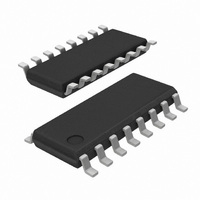SI2400-KS Silicon Laboratories Inc, SI2400-KS Datasheet - Page 32

SI2400-KS
Manufacturer Part Number
SI2400-KS
Description
IC ISOMODEM SYSTEM-SIDE 16SOIC
Manufacturer
Silicon Laboratories Inc
Type
Integrated Global DAAr
Datasheet
1.SI3015-F-FS.pdf
(94 pages)
Specifications of SI2400-KS
Package / Case
16-SOIC (3.9mm Width)
Data Format
V.21, V.22, V.23, Bell 103, Bell 212A
Baud Rates
2.4k
Interface
UART
Voltage - Supply
3 V ~ 5.25 V
Mounting Type
Surface Mount
Product
Modem Chip
Supply Voltage (min)
3 V
Supply Current
21 mA
Maximum Operating Temperature
+ 85 C
Minimum Operating Temperature
- 40 C
Mounting Style
SMD/SMT
Lead Free Status / RoHS Status
Contains lead / RoHS non-compliant
For Use With
336-1166 - BOARD EVAL FOR SI2400 ISOMODEM
Lead Free Status / RoHS Status
Lead free / RoHS Compliant, Contains lead / RoHS non-compliant
Other names
336-1093
Available stocks
Company
Part Number
Manufacturer
Quantity
Price
Part Number:
SI2400-KS
Manufacturer:
SILICON LABS/èٹ¯ç§‘
Quantity:
20 000
Part Number:
SI2400-KSR
Manufacturer:
SI
Quantity:
20 000
Si2400
must be disabled by setting S14[7] (MRCD) = 1
using this command to ensure the host does not
confuse a result code with data. w## and r# are not
required to be on separate lines (no <CR> between
them). Once a <CR> is encountered, AT is required to
begin the next AT command. For example, write the
value 58h to S34 and read it back using # commands
and ATSR commands.
The economy of the # commands is clearly evident from
this example. One caveat when using the # commands
is that the ASCII equivalents of the response can be
displayed as special or graphic characters when using a
terminal emulator program such as HyperTerminal.
However, in an embedded system, it is easy to send
non-ASCII characters.
6.4.5. m# Command Monitor S-Register
This command is similar to the r# command but is
repeated at the DTE rate until a new byte is transmitted
to the modem. The modem will echo the register
contents to the display as the ASCII equivalent of the
hexadecimal value of the contents. This command
executes immediately and does not require a carriage
return. Modem result codes must be disabled by setting
S14[7] (MRCD) = 1
ensure that the host does not confuse a result code with
data.
6.4.6. q# Command Read S-Register with 0x5500
This command is the same as the r# command except
that the response from the Si2400 is formatted as the
hexadecimal value 0x55aa where aa is the hexadecimal
value of the S-register contents. From a terminal, the #
following q is the ASCII equivalent of the hexadecimal
address of the S-register. This command executes
immediately and does not require a carriage return. The
0x5500 offset in the value of the register contents
prevents confusion between data and result codes and
permits the result codes to remain enabled.
32
ATS34=58S34
Terminal
ATw4Xr4
?<CR>
Entry
Offset
3D 35 38 53 33
41 54 77 34 58
41 54 53 33 34
Modem (hex)
b
34 3F 0D
Sent to
when using this command to
72 34
Response
35 38
(hex)
58
Display
b
58
X
when
Rev. 1.3
Z
The “Z” command causes a software reset to occur in
the device whereby the registers will return to their
default power up value with the exception of E0, E2,
E4–E7, F8, and F9. These registers are not reset, so
the Si2400 will maintain its current DTE settings, GPIO
definitions, tone detect and transmit settings, and
overload and billing tone detection status. The hardware
reset pin, RESET (Si2400, pin 8), is used to reset the
Si2400 to factory default settings. If other commands
follow on the same line, another AT is needed after the
“Z” (e.g., ATZATS07=06<CR>).
z
The Si2400 enters a low-power mode wherein the DSP
and microcontroller are powered down. The serial
interface also stops functioning. In this mode, only the
line-side chip (Si3015) and the communication link
function. An incoming ring signal or line transient
causes the Si2400 to power up and echo an “R”.
Without a ring signal, the host must perform a hardware
reset (Si2400, pin 8) to power up the Si2400. Return
from wake-on-ring can also be set to trigger the ALERT
pin by setting S62[4] (WOR) = 1
6.5. Alarm Industry AT Commands
The Si2400 supports a complete set of commands
necessary for making connections in security industry
systems. The Si2400 is configurable in three modes for
these applications. The first mode, DTMF send and
receive, is selected with the “!1” command. The second
mode uses FSK transmit with a tone acknowledgement
and is selected with “!2”. Finally, “!7” is selected for the
tone-on/tone-off mode.
The following are a few general comments about the
use of “!” commands. Specific details for each command
is given below. The first instance of the “!” must be on
the same line as the ATDT or ATDP command. DRT
must be set to data mode (SE4[5:4] (DRT) = 0
attempting to send tones after a “!” command. The three
data-mode escape sequences (“+++”, “escape” pin and
“ninth-bit”) only function in “!2” mode. However, using
the “+++” or “ninth-bit” is not recommended because
characters could be sent to and misinterpreted by the
remote modem. Only the “escape pin” (Si2400, pin 14)
is recommended for use in the “!2” mode. The “!1” and
“!7” modes have special escape provisions described in
their respective sections below. The AT commands for
Alarm Industry applications are described in Table 18.
Software Reset (upper-case Z)
Wakeup on Ring (lower-case z)
b
.
b
) before













